Advancing SDG5: Machine Learning and Statistical Graphics for Women’s Empowerment and Gender Equity
Abstract
1. Introduction
- Empirical Identification of Drivers: Quantitatively identifies education, financial inclusion, and legal awareness as key factors influencing women’s economic participation in the digital era.
- Advanced Analytical Application: It applies ML and statistical models (RF, SVM, logistic regression, neural networks) to rigorously analyze social engagement patterns.
- Insightful Predictive Modeling: Demonstrates the effectiveness of SVM and neural networks in predicting economic participation and the use of legal services among women.
- Data-Driven Policy Recommendations: Provides actionable policy insights to improve education, financial access, and legal empowerment towards gender equity.
- Visualization of Progress and Gaps: Uses graphical analysis to highlight both advances and persistent disparities in the economic inclusion of women.
2. Background and Related Work
2.1. Socioeconomic Background
2.2. The Pursuit of Gender Equity: Insights from SDG5
2.3. Educational Attainment on Women’s Socioeconomic Empowerment
2.4. Financial Barriers on Women’s Economic Autonomy
2.5. Women’s Access to Legal Services and Rights Awareness
2.6. Machine Learning in Social Science
2.7. Statistical Analysis in Social Science
3. Methodology
3.1. Data Collection
3.2. Instrument Description
3.3. Participants
3.4. Distribution and Sampling
3.5. Dataset Description
- Demographics: Gender, age, educational levels (including those of immediate social circles, parents, siblings, peers, teachers), employment status, and income.
- Socioeconomic status: Income, employment history, and position.
- Perceived gender equity: Attitudes towards gender egalitarianism on the job (remuneration, promotions, recognition) and access to social protection.
- Access to resources: Financial services utilization (e.g., bank/savings accounts, credit cards), legal services, and awareness of rights.
3.6. Research Questions
- (R.Q.1) How do educational attainment levels among women influence their participation in the labor market and entrepreneurial activities?
- (R.Q.2) What barriers to accessing financial services do women face and how do such barriers affect their financial independence?
- (R.Q.3) What role does access to legal services and awareness of legal rights play in empowering women?
3.7. Data Preprocessing
3.8. SDG5 Mapping
4. Results and Evaluation
4.1. Educational Empowerment and Economic Participation
4.1.1. Model Development for Educational Attainment
4.1.2. Graphical Data Visualization for Educational Attainment
4.1.3. Model Evaluation for Educational Attainment
4.1.4. SDG5 Implications: Educational Empowerment and Economic Participation
4.2. Financial Barriers and Access
4.2.1. Model Development for Financial Independence
4.2.2. Graphical Data Visualizations for Financial Independence
4.2.3. Model Evaluation for Financial Independence
4.2.4. SDG5 Implications: Financial Barriers and Access
4.3. Legal Access and Rights Awareness
4.3.1. Model Development for Legal Rights
4.3.2. Graphical Data Visualizations for Legal Rights
4.3.3. Model Evaluation for Legal Rights
4.3.4. SDG5 Implications: Legal Access and Rights Awareness
4.4. Cross-Validation Performance of Machine Learning Models
5. Discussion and Implications
5.1. Theoretical Implications
- We provide empirical evidence that empowerment stems from non-linear complementarities, with education serving not only as an independent predictor but also as a catalyst for financial and legal agency, thus supporting the implementation of integrated, multisector policy bundles over isolated interventions [13,14].
5.2. Practical Implications
- Policymakers: Design and implement coordinated, multisectoral interventions that concurrently enhance access to quality education, formal financial services, and legal resources. The detected gender disparity in access to social protection (p = 0.02) highlights the imperative for targeted reforms in safety nets and welfare programs, thereby aligning with principles of inclusive sustainability governance [14].
- Educational institutions: Utilize digital curricula and tools to augment the preparedness of young women for evolving labor markets, consistent with the strong predictive associations observed between educational attainment and labor market participation (SVM macro F1 = 0.77), and in support of technology-enabled inclusion agendas [1].
- Financial sector actors: Leverage the high access rates for fundamental financial products (bank accounts 98.8%, credit cards 96.3%, savings 93.8%) as indicators of progress, whilst employing granular analytics to address remaining disparities in product design, distribution channels, and consumer protection [27].
- Legal service providers and civil society: Augment initiatives for legal literacy and accessible services. The neural network’s efficacy (F1 = 0.81) associates legal empowerment with enhanced agency and reported outcomes, underscoring the benefits of building legal capabilities within empowerment strategies [26,31].
5.3. Socio-Cultural Influences on Women’s Empowerment
5.4. Comparative Analysis of Women’s Empowerment Across Regions
5.5. Ethical Considerations in Machine Learning Applications
5.6. Limitations and Future Research
5.6.1. Data
5.6.2. External Validity
5.6.3. Causality
5.6.4. Research Agenda
6. Conclusions
Funding
Institutional Review Board Statement
Informed Consent Statement
Data Availability Statement
Conflicts of Interest
Abbreviations
| Adam | Adaptive Moment Estimation |
| AI | Artificial Intelligence |
| CSR | Corporate Social Responsibility |
| EDA | Exploratory Data Analysis |
| FN | False Negative |
| FP | False Positive |
| Null Hypothesis | |
| LLM | Large Language Model |
| LIME | Local Interpretable Model-agnostic Explanations |
| ML | Machine Learning |
| MLP | Multilayer Perceptron |
| NaN | Not a Number |
| NLP | Natural Language Processing |
| p | p-value |
| ReLU | Rectified Linear Unit |
| RBF | Radial Basis Function |
| RF | Random Forest |
| SDG | Sustainable Development Goal |
| SVM | Support Vector Machine |
| STD | Standard Deviation |
| SHAP | SHapley Additive exPlanations |
| SMOTE | Synthetic Minority Over-sampling TEchnique |
| TP | True Positive |
| Chi-square Statistic | |
| n | Sample Size |
| XAI | Explainable Artificial Intelligence |
Appendix A
- Gender:
- Male
- Female
- Age:
- Younger than 20
- 20 to 30
- 31 to 40
- 41 to 50
- Older than 50
Section 2 of 12: Education - What is the highest level of education completed:[Scales: Individual/Parents/Siblings/Peers/Teachers]
- ∗
- Illiterate
- ∗
- Primary School
- ∗
- Middle School
- ∗
- High School
- ∗
- Diploma
- ∗
- Bachelor
- ∗
- Master
- ∗
- Doctorate
Section 3 of 12: Employment - Salary:
- Not Applicable
- Less than 5000
- 5000 to 10,000
- 10,000 to 15,000
- More than 15,000
- Employment status:
- Student
- Government employee
- Private sector employee
- Self-employed
- At liberty
- Experience in current job:
- ∗
- Not Applicable
- ∗
- Less than a year
- ∗
- 1–2 years
- ∗
- 3–5 years
- ∗
- 6–10 years
- ∗
- More than 10 years
- Equity in Employment: [Scales: Yes/No/I don’t know/Not Applicable]
- paid the same as your colleagues of the same gender?
- have the same opportunities for promotion as your colleagues of the same gender?
- treated the same as your colleagues of the same gender?
- given the same amount of responsibility as your colleagues of the same gender?
- given the same amount of recognition as your colleagues of the same gender?
Section 4 of 12: Political Representation - Percentage of women in leadership positions:
- 1–9%
- 10–29%
- 30–49%
- 50–69%
- 70–89%
- 90–100%
- Are there any organizations or initiatives that support women in: [Scales: Yes/No/I don’t know]
- Politics
- Running for leadership positions
- Fundraising
- Networking
- Policymaking
- Media representation
Section 5 of 12: Healthcare - Do you have access to healthcare services: [Scales: Yes/No/I don’t know]
- Are there any differences in access to healthcare services between: [Scales: Yes/No/I don’t know]
- Gender
- Age groups
- Income levels
- Ethnic groups
Section 6 of 12: Legal Rights - Do you have access to legal services: [Scales: Yes/No/I don’t know]
- Experience with the legal system: [Bad (1) to Good (5)]
- Gender-based discrimination in the legal system: [Scales: Yes/No/I don’t know]Section 7 of 12: Financial Services
- Do you have access to financial services: [Scales: Yes/No/Not Applicable]
- ∗
- Bank account
- ∗
- Credit card
- ∗
- Loan
- ∗
- Savings account
- ∗
- Debit card
- ∗
- Mobile money account
- ∗
- Prepaid card
- ∗
- Digital wallet
- ∗
- Financial advisor
- ∗
- Financial literacy program
Section 8 of 12: Access to Technology - Do you have access to Devices: [Scales: Yes/No/Not Applicable]
- ∗
- Computer or laptop
- ∗
- Internet
- ∗
- Smartphone
- ∗
- Tablet
- ∗
- Others
- Frequency of use:
- Not Applicable
- Discreetly
- Rarely
- 2–3 h/day
- 4–6 h/day
- Freely
Section 9 of 12: Public ServicesExamples of public services include: Courts, Education, Electricity, Emergency services, Environmental protection, Healthcare, Mail, Military. - Rate the following: [Scales: Low/Below average/Average/Above average/High]
- Availability of services
- Quality of services
- Cost of services
- Ease of access to services
- Gender of people using, providing, or benefiting from services:
- Mostly men
- Mostly women
- Both
- I don’t know
Section 10 of 12: Social Protection - Differences in social protection services: [Scales: Yes/No/Not Applicable]
- Access
- Quality
- Availability
- Affordability
- Coverage
- Timeliness
- Effectiveness
- Utilization
- Satisfaction
Section 11 of 12: Statements - Rate your agreement with the following statements: [Scales: Totally agree/Somewhat agree/Neutral/Somewhat disagree/Totally disagree]
- Women should have the same rights as men
- Women should be allowed to work outside the home
- Women should be allowed to make their own decisions
- Women should be respected and treated equally
- Women should be allowed to pursue higher education
- Women should be allowed to participate in politics
- Women should be allowed to travel freely
- Women should be allowed to dress as they please
- Women should be allowed to express their opinions freely
- Women should be allowed to choose their own partners
- Women should be allowed to own property
- Women should be allowed to access healthcare
- Women should be allowed to access legal services
Section 12 of 12: Open Questions - In your opinion, what can society provide to embrace women?
- In your opinion, what can society do to hinder women?
References
- UN Women. Making Innovation and Technology Work for Women, 2017. Recuperado a Partir de La Desigualdad de Género en la Economía Digital Mexicana. Available online: https://www.unwomen.org/en/digital-library/publications/2017/7/making-innovation-and-technology-work-for-women (accessed on 23 October 2025).
- Djatmiko, G.H.; Sinaga, O.; Pawirosumarto, S. Digital Transformation and Social Inclusion in Public Services: A Qualitative Analysis of E-Government Adoption for Marginalized Communities in Sustainable Governance. Sustainability 2025, 17, 2908. [Google Scholar] [CrossRef]
- Akanfe, O.; Bhatt, P.; Lawong, D.A. Technology Advancements Shaping the Financial Inclusion Landscape: Present Interventions, Emergence of Artificial Intelligence and Future Directions. Inf. Syst. Front. 2025, 27, 1–24. [Google Scholar] [CrossRef]
- Alqahtani, M.H. Women in Saudi secondary school EFL textbooks: A critical study of women’s empowerment as enshrined in the Saudi Vision 2030. Front. Sociol. 2024, 9, 1307623. [Google Scholar] [CrossRef]
- Al-Ghamdi, N.A.; Alqahtani, A.; Alshahrani, L.; Elyas, T. A semiotic analysis of images of Saudi Women’s rights in caricatures in light of Saudi Women’s empowerment. Semiotica 2022, 2022, 217–247. [Google Scholar] [CrossRef]
- Alhawsawi, S.; Jawhar, S.S. Education, employment, and empowerment among Saudi women. Gend. Educ. 2023, 35, 401–419. [Google Scholar] [CrossRef]
- Samargandi, N.; Al Mamun, M.; Sohag, K.; Alandejani, M. Women at work in Saudi Arabia: Impact of ICT diffusion and financial development. Technol. Soc. 2019, 59, 101187. [Google Scholar] [CrossRef]
- Yang, Y.; Zhang, C.; Xu, H.; Bu, Y.; Liu, M.; Ding, Y. Unveiling the loss of exceptional women in science. Inf. Process. Manag. 2024, 61, 103829. [Google Scholar] [CrossRef]
- Mishra, D.; Kandpal, V.; Agarwal, N.; Srivastava, B. Financial Inclusion and Its Ripple Effects on Socio-Economic Development: A Comprehensive Review. J. Risk Financ. Manag. 2024, 17, 105. [Google Scholar] [CrossRef]
- Corradini, E. Deconstructing cultural appropriation in online communities: A multilayer network analysis approach. Inf. Process. Manag. 2024, 61, 103662. [Google Scholar] [CrossRef]
- Dritsas, E.; Trigka, M. Machine Learning and Data Science in Social Sciences: Methods, Applications, and Future Directions. IEEE Access 2025, 13, 105334–105352. [Google Scholar] [CrossRef]
- Srour, F.J.; Karkoulian, S. Exploring diversity through machine learning: A case for the use of decision trees in social science research. Int. J. Soc. Res. Methodol. 2022, 25, 725–740. [Google Scholar] [CrossRef]
- United Nations. The Sustainable Development Goals Report; United Nations: New York, NY, USA, 2016. [Google Scholar]
- Bebbington, J.; Unerman, J. Achieving the United Nations sustainable development goals. Accounting, Audit. Account. J. 2018, 31, 2–24. [Google Scholar] [CrossRef]
- AlKharouf, R.; Shehadeh, A.; Alrefaee, A.; Alshboul, O. Integrative strategies for social inclusion and equity: Enhancing refugee access to higher education in Jordan. Heliyon 2024, 10, e31762. [Google Scholar] [CrossRef]
- Moss, N.E. Gender equity and socioeconomic inequality: A framework for the patterning of women’s health. Soc. Sci. Med. 2002, 54, 649–661. [Google Scholar] [CrossRef]
- Vaz, E. Regional Knowledge Economies; Springer: Berlin/Heidelberg, Germany, 2024. [Google Scholar] [CrossRef]
- Chikh-Amnache, S.; Mekhzoumi, L. The influence of socioeconomic factors on female entrepreneurship in Southeast Asian countries. J. Entrep. Emerg. Econ. 2024, 16, 33–70. [Google Scholar] [CrossRef]
- Perifanis, N.A.; Kitsios, F. Investigating the Influence of Artificial Intelligence on Business Value in the Digital Era of Strategy: A Literature Review. Information 2023, 14, 85. [Google Scholar] [CrossRef]
- Nilan, P.; Maunati, Y. Wealth, Poverty and Health in Southeast Asia. In Decolonising Social Science Research in Southeast Asia: New Ways of Knowing; Springer: Berlin/Heidelberg, Germany, 2025; pp. 85–110. [Google Scholar] [CrossRef]
- Tong, Y.; Chen, R.K. Rethinking Gender Inequality in China’s Rural-to-Urban Migration: An Intersectionality Approach. Sociol. Compass 2025, 19, e70075. [Google Scholar] [CrossRef]
- Sethi, S.S.; Jain, K. AI technologies for social emotional learning: Recent research and future directions. J. Res. Innov. Teach. Learn. 2024, 17, 213–225. [Google Scholar] [CrossRef]
- Ukhova, D. Gender inequality and inter-household economic inequality in emerging economies: Exploring the relationship. Gend. Dev. 2015, 23, 241–259. [Google Scholar] [CrossRef]
- Carroll, A.B.; Brown, J.A. Corporate social responsibility: A review of current concepts, research, and issues. In Corporate Social Responsibility; Emerald Publishing Limited: Leeds, UK, 2018; Volume 2, pp. 39–69. [Google Scholar] [CrossRef]
- Schaltegger, S. Linking Environmental Management Accounting: A Reflection on (Missing) Links to Sustainability and Planetary Boundaries. Soc. Environ. Account. J. 2018, 38, 19–29. [Google Scholar] [CrossRef]
- Di Vaio, A.; Hassan, R.; Palladino, R. Blockchain technology and gender equality: A systematic literature review. Int. J. Inf. Manag. 2023, 68, 102517. [Google Scholar] [CrossRef]
- Ali, S.; Appolloni, A.; Cavallaro, F.; D’Adamo, I.; Di Vaio, A.; Ferella, F.; Gastaldi, M.; Ikram, M.; Kumar, N.; Martin, M.; et al. Development Goals towards Sustainability. Sustainability 2023, 15, 9443. [Google Scholar] [CrossRef]
- Appolloni, A.; Jabbour, C.J.C.; D’Adamo, I.; Gastaldi, M.; Settembre-Blundo, D. Green recovery in the mature manufacturing industry: The role of the green-circular premium and sustainability certification in innovative efforts. Ecol. Econ. 2022, 193, 107311. [Google Scholar] [CrossRef]
- D’Adamo, I.; Lupi, G. Sustainability and resilience after COVID-19: A circular premium in the fashion industry. Sustainability 2021, 13, 1861. [Google Scholar] [CrossRef]
- UK COP26 Presidency. The Role of Gender Equality in Decarbonizing Transport. 2021. Available online: https://ukcop26.org/events/the-role-of-gender-equality-in-decarbonising-transport/ (accessed on 23 October 2025).
- Di Vaio, A.; Zaffar, A.; Balsalobre-Lorente, D.; Garofalo, A. Decarbonization technology responsibility to gender equality in the shipping industry: A systematic literature review and new avenues ahead. J. Shipp. Trade 2023, 8, 9. [Google Scholar] [CrossRef]
- Kasnauskiene, G.; Badaras, R.; Pauliene, R.; Thrassou, A. Economic effectiveness of investment in higher education: An evaluation at the individual and national levels. Euromed J. Bus. 2024, 20, 1–16. [Google Scholar] [CrossRef]
- Elsayed, A.; Shirshikova, A. The women-empowering effect of higher education. J. Dev. Econ. 2023, 163, 103101. [Google Scholar] [CrossRef]
- Le, K.; Nguyen, M. How Education Empowers Women in Developing Countries. BE J. Econ. Anal. Policy 2021, 21, 511–536. [Google Scholar] [CrossRef]
- Yadav, A.K.; Sahni, B.; Jena, P.K. Education, employment, economic status and empowerment: Implications for maternal health care services utilization in India. J. Public Aff. 2021, 21, e2259. [Google Scholar] [CrossRef]
- Braverman-Bronstein, A.; Ortigoza, A.F.; Vidaña-Pérez, D.; Barrientos-Gutiérrez, T.; Baldovino-Chiquillo, L.; Bilal, U.; de Lima Friche, A.A.; Diez-Canseco, F.; Maslowsky, J.; Vives V., A.; et al. Gender inequality, women’s empowerment, and adolescent birth rates in 363 Latin American cities. Soc. Sci. Med. 2023, 317, 115566. [Google Scholar] [CrossRef]
- Cin, F.M.; Gümüş, S.; Weiss, F. Women’s empowerment in the period of the rapid expansion of higher education in Turkey: Developments and paradoxes of gender equality in the labour market. High. Educ. 2021, 81, 31–50. [Google Scholar] [CrossRef]
- Parveen, M. Women empowerment: New paradigm shift of Saudi women into labor workforce. Soc. Bus. Rev. 2021, 17, 66–91. [Google Scholar] [CrossRef]
- Saluja, O.B.; Singh, P.; Kumar, H. Barriers and interventions on the way to empower women through financial inclusion: A 2 decades systematic review (2000–2020). Humanit. Soc. Sci. Commun. 2023, 10, 148. [Google Scholar] [CrossRef]
- Al-shami, S.A.; Al Mamun, A.; Rashid, N.; Al-shami, M. Microcredit Impact on Socio-Economic Development and Women Empowerment in Low-Income Countries: Evidence from Yemen. Sustainability 2021, 13, 9326. [Google Scholar] [CrossRef]
- Pal, M.; Gupta, H.; Joshi, Y.C. Social and economic empowerment of women through financial inclusion: Empirical evidence from India. Equal. Divers. Incl. Int. J. 2021, 41, 294–305. [Google Scholar] [CrossRef]
- Aziz, F.; Sheikh, S.M.; Shah, I.H. Financial inclusion for women empowerment in South Asian countries. J. Financ. Regul. Compliance 2022, 30, 489–502. [Google Scholar] [CrossRef]
- Puh, K.M.C.; Yiadom, A.; Johnson, J.; Fernando, F.; Gruet, L. Chapter 13 Legal Rights: Women’s Economic Empowerment—Case Studies. In Gender Equality and Economic Development in Sub-Saharan Africa; International Monetary Fund: Bretton Woods, NH, USA, 2024; p. CH013. [Google Scholar] [CrossRef]
- Reddy, R.G.; Rani, P. Legal empowerment and status of women. J. Community Mobilization Sustain. Dev. 2024, 19, 541–546. [Google Scholar] [CrossRef]
- Maru, V. Access to Justice and Legal Empowerment: A Review of World Bank Practice. Hague J. Rule Law 2010, 2, 259–281. [Google Scholar] [CrossRef][Green Version]
- Goodwin, L.; Maru, V. What do we know about legal empowerment? Mapping the evidence. Hague J. Rule Law 2017, 9, 157–194. [Google Scholar] [CrossRef]
- Joshi, A.; Schaaf, M.; Zayed, D. The use of legal empowerment to improve access to quality health services: A scoping review. Int. J. Equity Health 2022, 21, 136. [Google Scholar] [CrossRef] [PubMed]
- Liu, M.; Xie, Z.; Yang, A.J.; Yu, C.; Xu, J.; Ding, Y.; Bu, Y. The prominent and heterogeneous gender disparities in scientific novelty: Evidence from biomedical doctoral theses. Inf. Process. Manag. 2024, 61, 103743. [Google Scholar] [CrossRef]
- Qian, Z.; Li, J.; Zhang, Y.; Liu, Y.; Wang, Q. Understanding gender differences in online protective products purchases through an impression management perspective: Evidence from a natural experiment. Inf. Process. Manag. 2025, 62, 104181. [Google Scholar] [CrossRef]
- Grimmer, J.; Roberts, M.E.; Stewart, B.M. Machine Learning for Social Science: An Agnostic Approach. Annu. Rev. Political Sci. 2021, 24, 395–419. [Google Scholar] [CrossRef]
- Sheetal, A.; Jiang, Z.; Di Milia, L. Using machine learning to analyze longitudinal data: A tutorial guide and best-practice recommendations for social science researchers. Appl. Psychol. 2023, 72, 1339–1364. [Google Scholar] [CrossRef]
- Shu, X.; Ye, Y. Knowledge Discovery: Methods from data mining and machine learning. Soc. Sci. Res. 2023, 110, 102817. [Google Scholar] [CrossRef]
- Grossmann, I.; Feinberg, M.; Parker, D.C.; Christakis, N.A.; Tetlock, P.E.; Cunningham, W.A. AI and the transformation of social science research. Science 2023, 380, 1108–1109. [Google Scholar] [CrossRef] [PubMed]
- Castorena, C.M.; Abundez, I.M.; Alejo, R.; Granda-Gutiérrez, E.E.; Rendón, E.; Villegas, O. Deep Neural Network for Gender-Based Violence Detection on Twitter Messages. Mathematics 2021, 9, 807. [Google Scholar] [CrossRef]
- Kaplan, D. Bayesian Statistics for the Social Sciences; Guilford Publications: New York, NY, USA, 2023. [Google Scholar]
- Abu-Bader, S. Using Statistical Methods in Social Science Research: With a Complete SPSS Guide; Oxford University Press: Oxford, UK, 2021. [Google Scholar]
- UNGUREANU, L. Statistics in Social Sciences. J. Res. Educ. Sci. 2024, 15, 57–71. [Google Scholar] [CrossRef]
- Simon, V.; Rabin, N.; Gal, H.C.B. Utilizing data driven methods to identify gender bias in LinkedIn profiles. Inf. Process. Manag. 2023, 60, 103423. [Google Scholar] [CrossRef]
- Fabris, A.; Purpura, A.; Silvello, G.; Susto, G.A. Gender stereotype reinforcement: Measuring the gender bias conveyed by ranking algorithms. Inf. Process. Manag. 2020, 57, 102377. [Google Scholar] [CrossRef]
- Slokom, M.; Hanjalic, A.; Larson, M. Towards user-oriented privacy for recommender system data: A personalization-based approach to gender obfuscation for user profiles. Inf. Process. Manag. 2021, 58, 102722. [Google Scholar] [CrossRef]
- Silva, M.O.; de Melo-Gomes, L.; Moro, M.M. From words to gender: Quantitative analysis of body part descriptions within literature in Portuguese. Inf. Process. Manag. 2024, 61, 103647. [Google Scholar] [CrossRef]
- Breur, T. Statistical Power Analysis and the contemporary “crisis” in social sciences. J. Mark. Anal. 2016, 4, 61–65. [Google Scholar] [CrossRef]
- Hofman, J.M.; Watts, D.J.; Athey, S.; Garip, F.; Griffiths, T.L.; Kleinberg, J.; Margetts, H.; Mullainathan, S.; Salganik, M.J.; Vazire, S.; et al. Integrating explanation and prediction in computational social science. Nature 2021, 595, 181–188. [Google Scholar] [CrossRef] [PubMed]
- Campisi, T.; Skoufas, A.; Kaltsidis, A.; Basbas, S. Gender Equality and E-Scooters: Mind the Gap! A Statistical Analysis of the Sicily Region, Italy. Soc. Sci. 2021, 10, 403. [Google Scholar] [CrossRef]
- Kingma, D.P.; Ba, J. Adam: A Method for Stochastic Optimization. CoRR 2014, 1412, 6980. Available online: https://api.semanticscholar.org/CorpusID:6628106 (accessed on 23 October 2025).
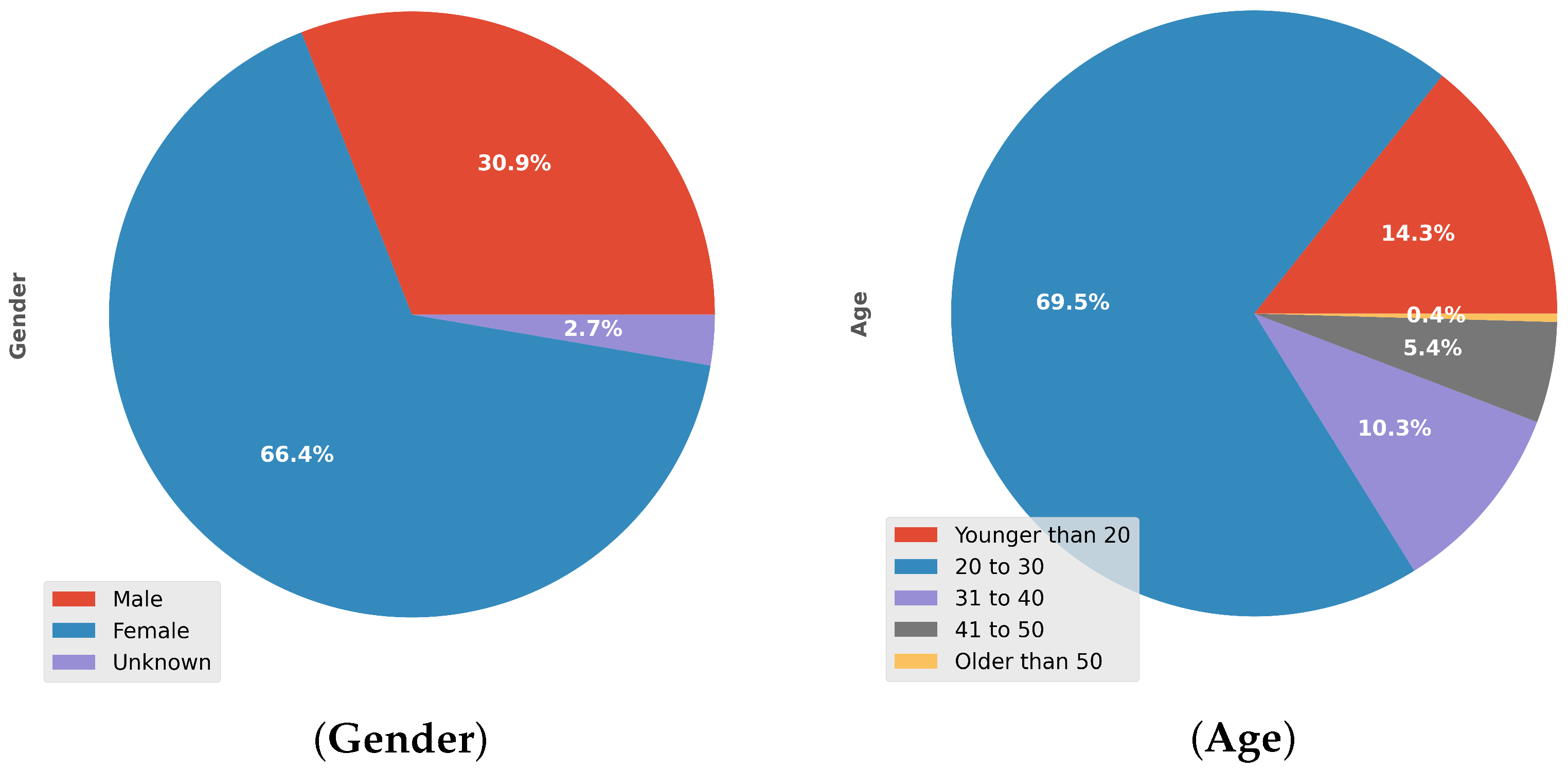
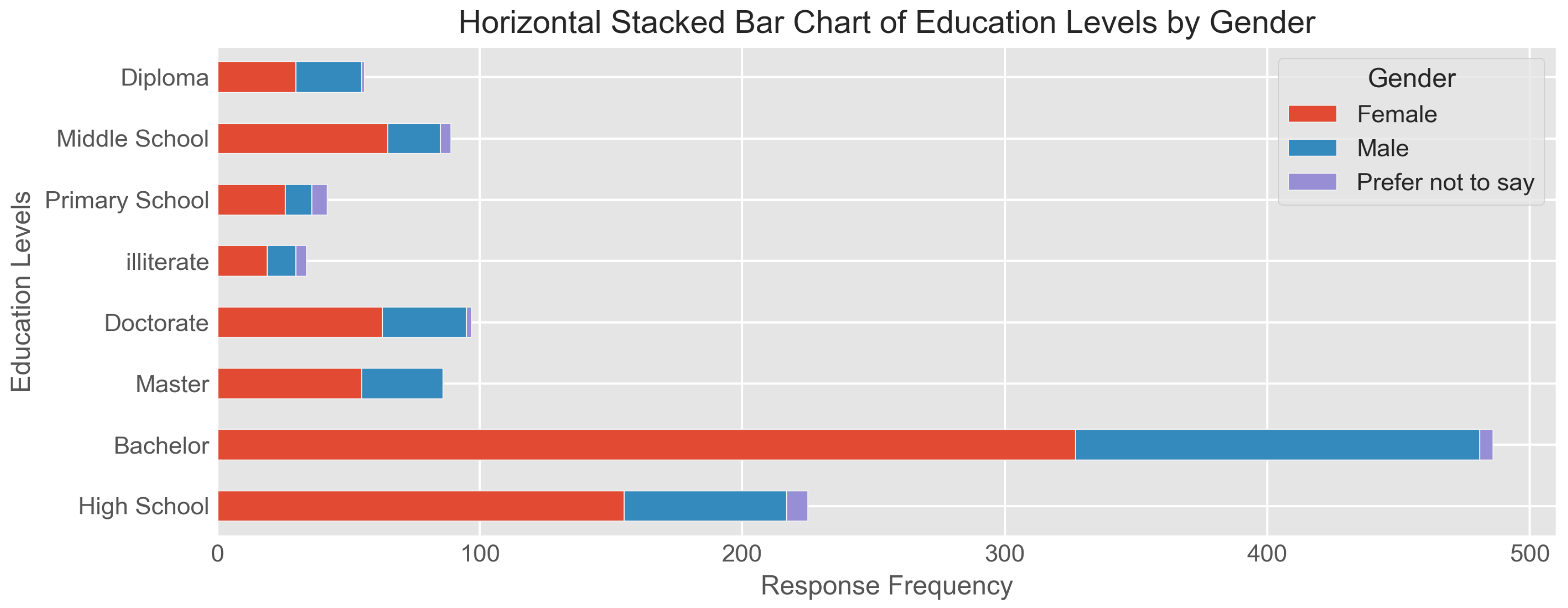

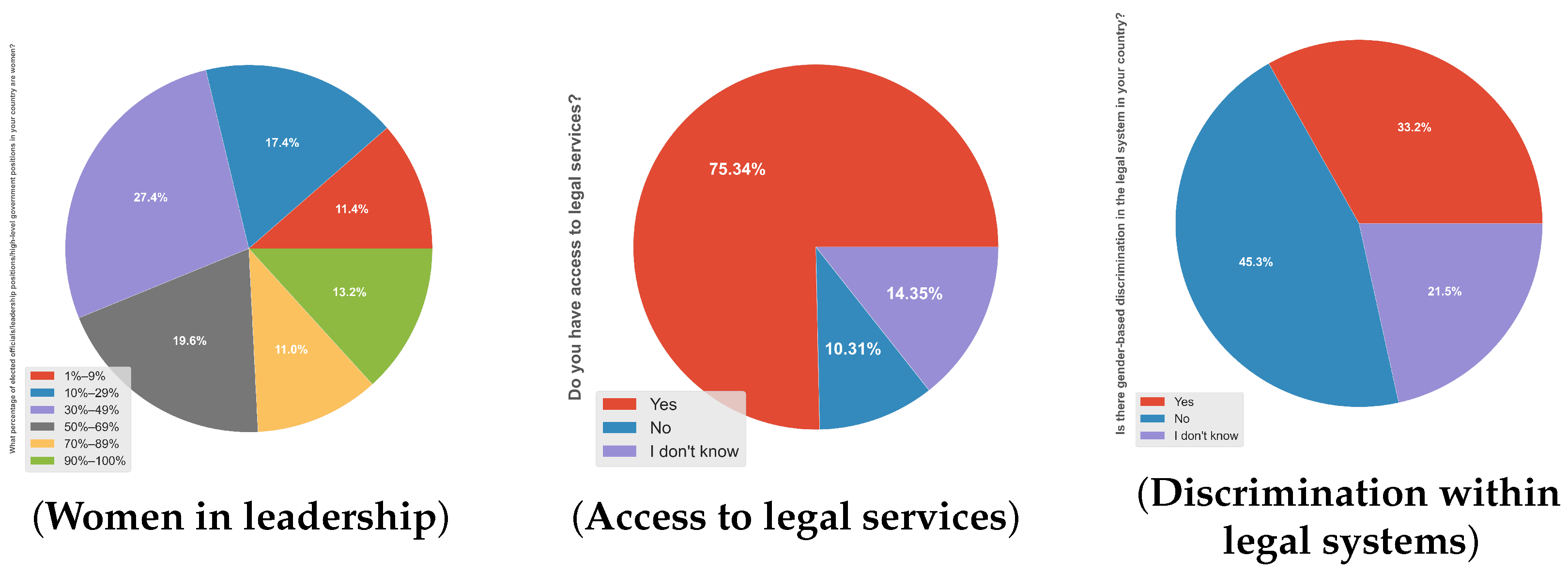





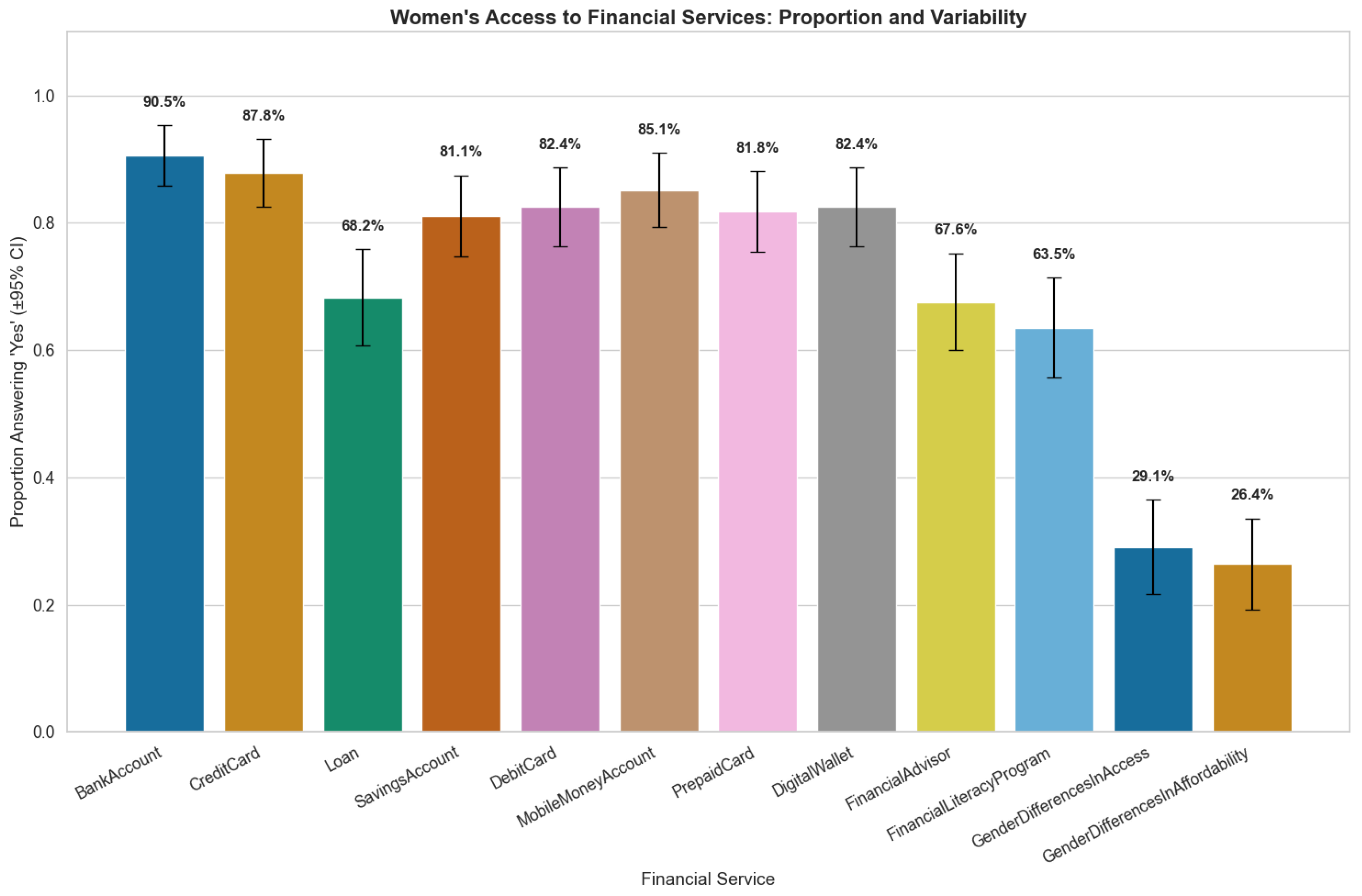
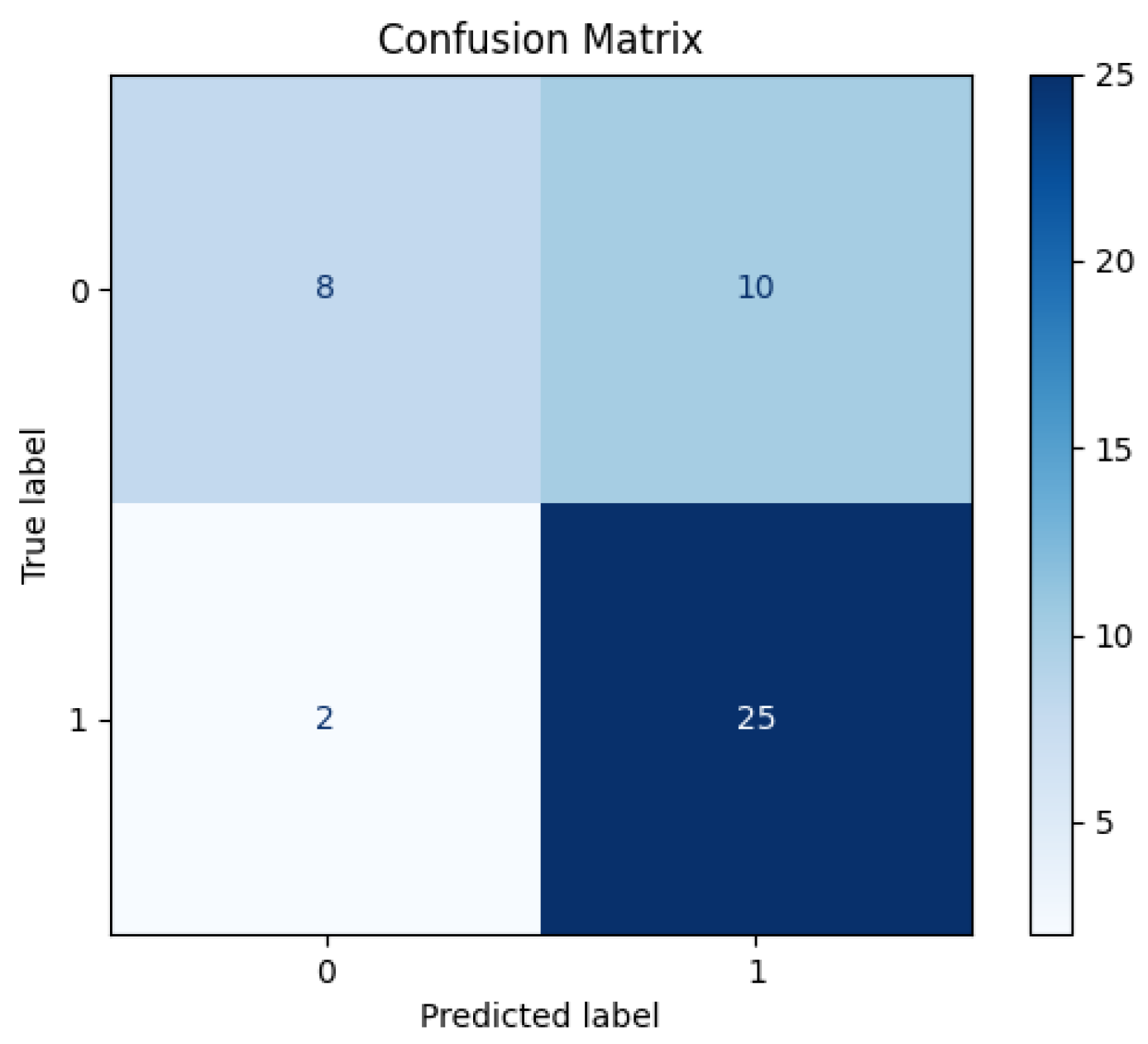

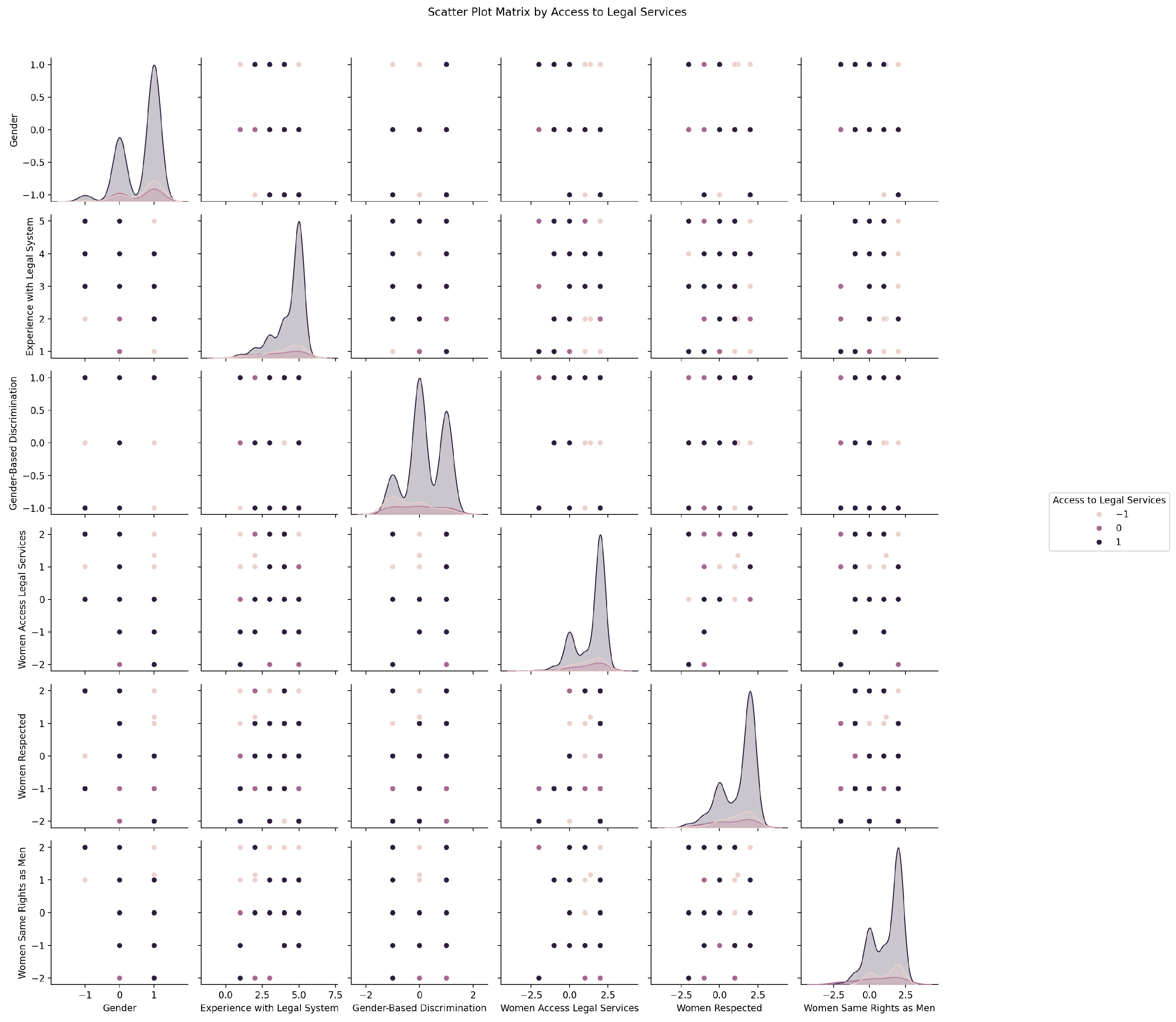

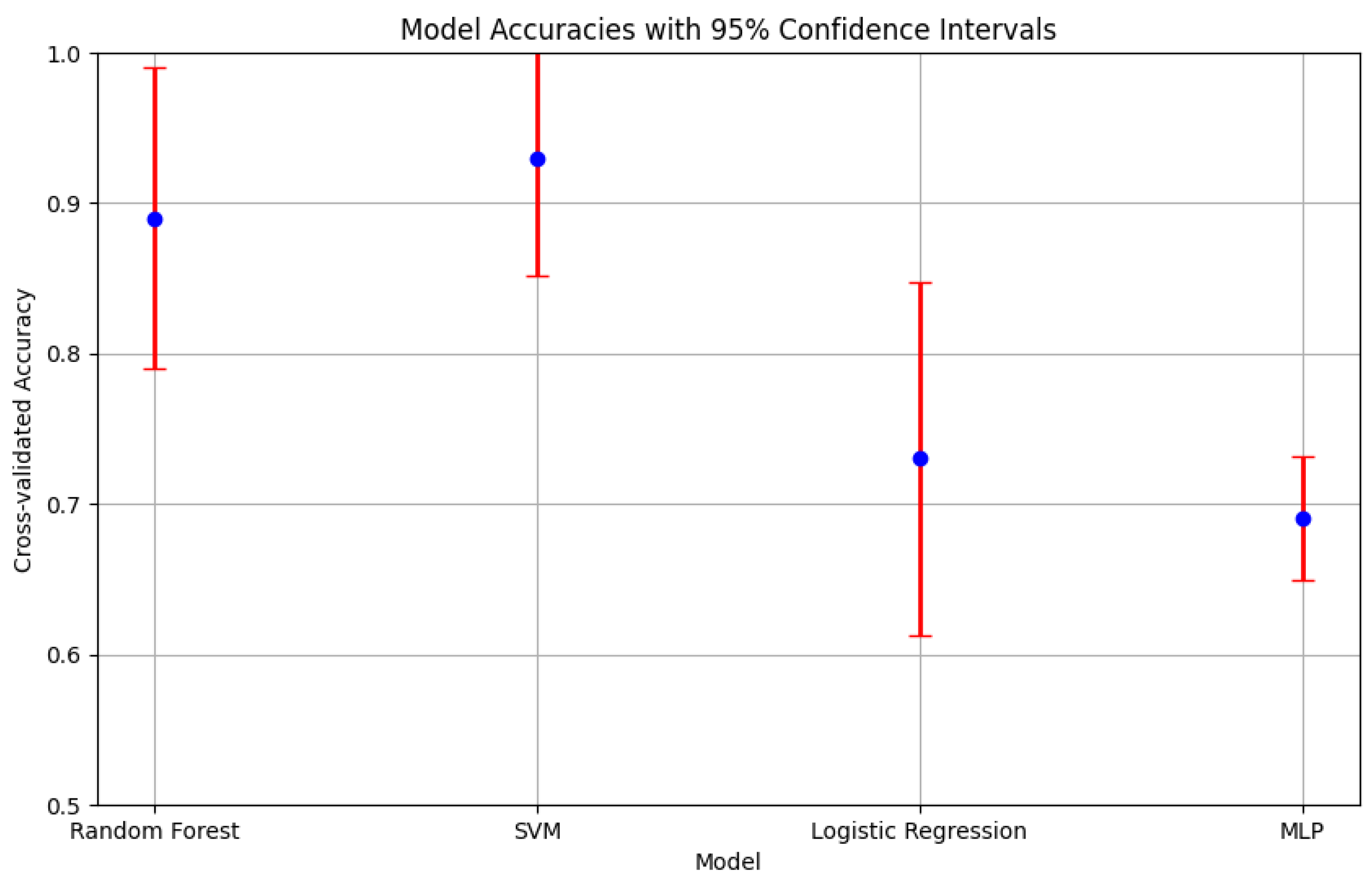
| Gender | Female | Male | Unknown |
|---|---|---|---|
| Total | |||
| 148 | 68 | 6 | |
| Income | |||
| 10,000 to 15,000 | 10.0 | 9.0 | 0.0 |
| 5000 to 10,000 | 20.0 | 19.0 | 1.0 |
| Less than 5000 | 29.0 | 11.0 | 4.0 |
| More than 15,000 | 10.0 | 15.0 | 0.0 |
| Not Applicable | 79.0 | 15.0 | 1.0 |
| Employment Status | |||
| At liberty | 4.0 | 2.0 | 0.0 |
| Government | 21.0 | 27.0 | 2.0 |
| Private sector | 9.0 | 12.0 | 1.0 |
| Self-employee | 4.0 | 5.0 | 1.0 |
| Student | 110.0 | 23.0 | 2.0 |
| Work Experience | |||
| 1–2 years | 11.0 | 9.0 | 0.0 |
| 3–5 years | 10.0 | 14.0 | 2.0 |
| 6–10 years | 5.0 | 7.0 | 2.0 |
| Less than a year | 13.0 | 9.0 | 1.0 |
| More than 10 years | 7.0 | 12.0 | 0.0 |
| Not Applicable | 102.0 | 18.0 | 1.0 |
| Model | Hyperparameters |
|---|---|
| Random Forest | Trees: 100/200, Max Depth: None/10/20, Min Samples Split: 2/5, Min Samples Leaf: 1/2 |
| SVM | Kernel: Linear/RBF, Gamma: Scale/Auto, C: 0.1/1/10, Class Weight: Balanced |
| MLP | Hidden Layers: (100,), Activation: ReLU, Solver: Adam, Iterations: 200, Random State: 42 |
| Logistic Regression | Max Iterations: 1000 |
| Research Question | SDG5 Target/ Indicator | Variables/Measures | Expected Mechanisms |
|---|---|---|---|
| R.Q.1 | 5.5 | Education levels, Employment status | Increased participation in labor market and leadership roles |
| R.Q.2 | 5.a | Access to financial services, Financial literacy | Removal of barriers enhances economic independence |
| R.Q.3 | 5.1 | Legal service access, Awareness of rights | Greater empowerment through higher legal agency |
| Experience Code | Precision | Recall | F1-Score | Support |
|---|---|---|---|---|
| −1 | 1.00 | 1.00 | 1.00 | 20 |
| 0 | 1.00 | 0.33 | 0.50 | 3 |
| 1 | 0.71 | 0.83 | 0.77 | 6 |
| 2 | 0.86 | 1.00 | 0.92 | 6 |
| 3 | 0.50 | 1.00 | 0.67 | 2 |
| 4 | 1.00 | 0.75 | 0.86 | 8 |
| accuracy | 0.89 | 45 | ||
| macro avg | 0.85 | 0.82 | 0.79 | 45 |
| weighted avg | 0.92 | 0.89 | 0.89 | 45 |
| Experience Code | Precision | Recall | F1-Score | Support |
|---|---|---|---|---|
| −1 | 1.00 | 1.00 | 1.00 | 20 |
| 0 | 1.00 | 1.00 | 1.00 | 3 |
| 1 | 1.00 | 1.00 | 1.00 | 6 |
| 2 | 1.00 | 1.00 | 1.00 | 6 |
| 3 | 0.33 | 0.50 | 0.40 | 2 |
| 4 | 0.86 | 0.75 | 0.80 | 8 |
| accuracy | 0.93 | 45 | ||
| macro avg | 0.87 | 0.88 | 0.87 | 45 |
| weighted avg | 0.94 | 0.93 | 0.94 | 45 |
| Class | Precision | Recall | F1-Score | Support |
|---|---|---|---|---|
| 0 | 0.80 | 0.44 | 0.57 | 18 |
| 1 | 0.71 | 0.93 | 0.81 | 27 |
| accuracy | 0.73 | 45 | ||
| macro avg | 0.76 | 0.69 | 0.69 | 45 |
| weighted avg | 0.75 | 0.73 | 0.71 | 45 |
| Category | Precision | Recall | F1-Score | Support |
|---|---|---|---|---|
| −1.0 | 0.50 | 0.13 | 0.21 | 15 |
| 0.0 | 0.50 | 0.20 | 0.29 | 10 |
| 1.0 | 0.71 | 1.00 | 0.83 | 42 |
| accuracy | 0.69 | 67 | ||
| macro avg | 0.57 | 0.44 | 0.44 | 67 |
| weighted avg | 0.63 | 0.69 | 0.61 | 67 |
| Study | Key Findings | Similarity/Contrast |
|---|---|---|
| Current Study (Middle East) | Education, financial inclusion, and legal access drive empowerment. | Highlights regional barriers, similar to global findings. |
| Pal et al. [41] (India) | Financial inclusion as key empowerment driver in rural areas. | Similar—emphasis on financial inclusion but different urban challenges. |
| Maru’s Review [45] | Legal access is crucial for empowerment. | Similar—emphasizes legal services, varied urban barriers. |
| Braverman-Bronstein et al. [36] (Latin America) | Education reduces gender inequity. | Similar—education critical, context varies. |
| Yadav et al. [35] (India) | Education boosts maternal health care access. | Similar—highlights education’s strong influence. |
| Cin et al. [37] (Turkey) | Higher education impacts gender equity. | Contrast—urban vs. rural sociocultural barriers. |
Disclaimer/Publisher’s Note: The statements, opinions and data contained in all publications are solely those of the individual author(s) and contributor(s) and not of MDPI and/or the editor(s). MDPI and/or the editor(s) disclaim responsibility for any injury to people or property resulting from any ideas, methods, instructions or products referred to in the content. |
© 2025 by the author. Licensee MDPI, Basel, Switzerland. This article is an open access article distributed under the terms and conditions of the Creative Commons Attribution (CC BY) license (https://creativecommons.org/licenses/by/4.0/).
Share and Cite
Alhakamy, A. Advancing SDG5: Machine Learning and Statistical Graphics for Women’s Empowerment and Gender Equity. Sustainability 2025, 17, 9706. https://doi.org/10.3390/su17219706
Alhakamy A. Advancing SDG5: Machine Learning and Statistical Graphics for Women’s Empowerment and Gender Equity. Sustainability. 2025; 17(21):9706. https://doi.org/10.3390/su17219706
Chicago/Turabian StyleAlhakamy, A’aeshah. 2025. "Advancing SDG5: Machine Learning and Statistical Graphics for Women’s Empowerment and Gender Equity" Sustainability 17, no. 21: 9706. https://doi.org/10.3390/su17219706
APA StyleAlhakamy, A. (2025). Advancing SDG5: Machine Learning and Statistical Graphics for Women’s Empowerment and Gender Equity. Sustainability, 17(21), 9706. https://doi.org/10.3390/su17219706







